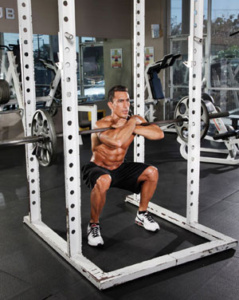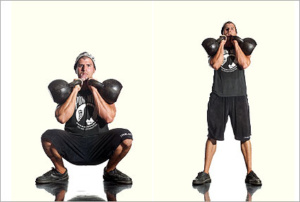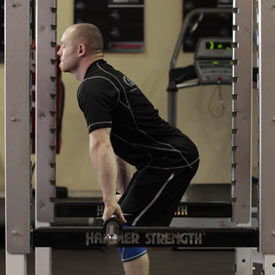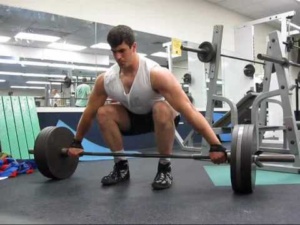Squat and Deadlift for Mass Question Answered
I get a lot of insightful questions every week and I do my best to get them answered. Sometimes, while writing out an answer I realize that many more people could benefit from the information. Therefore, today I’m sharing one answer to a recent question I received.
Chad, I want to say thanks for all you do. Because of you I lift fast, use full body workouts, incorporate single leg exercises, use high volume body weight exercises. At 31 I’m in the best shape I’ve ever been in my life! I’m 6’2″ and since Thanksgiving of last year have gone from 220lbs to 199. I was also able to keep my combined chest/shoulder measurement at 55″ while dropping my waist from 36 to 32 inches! I owe it all to Huge in a Hurry and your articles.
On to my question – sort of a “hypertrophy debate.” I’ve always thought that the squat and deadlift were the king of the mass builders – if that’s what you’re going for. However, lately I’ve read that the front squat may offer more in the way of muscular development…and the same for the stiff-legged deadlift. Can you weigh in on this for me? -Joseph C.
CW: Thanks for the kind words, Joseph. Yes, the squat and deadlift are two of the best mass builders you’ll find because they primarily target the largest muscles in the body. Now, the terms “squat” and “deadlift” have different definitions in different populations. For some, that literally translates to mean the barbell back squat and deadlift from the floor.
For other coaches like me, when we say to focus on the squat and deadlift for mass what we really mean are squat and deadlift variations. For example, the front squat and partial deadlift (pin pull) will add just as much muscle as the barbell back squat and full deadlift.
So the question is: which variation best suits your body type?
Most people can’t perform a barbell back squat correctly. It’s actually one of the most difficult lifts to get right, even though it’s considered a basic strength exercise that everyone should start with. The problem with the barbell back squat is that it requires high levels of mobility in the ankle, hips, adductors, hamstrings, T-spine, and shoulders. Plus, you need to have plenty of stability strength in your core or else you’ll lean excessively forward “in the hole.” If you pass all those requirements, the back squat is a good exercise.
The sequence of pics below shows the ideal form for the barbell back squat. If you can drop your hips below your knees with your heels down and your torso at 60-70 degrees, go for it.

But for most people there are better options, especially if you’re tall or have long legs.
The front squat has gained a lot of popularity over the years because the biomechanics are easier to get right. Since the load is in front of you, you can sit back easier without losing your balance. Second, you don’t need as much dorsiflexion in your ankle joints to do the front squat with perfect form. A lack of dorsiflexion (the ability to pull your foot toward your shin) is common in most people.
In terms of overall muscle activation, the front and back squat work many of the same muscle groups. People with a history of knee problems typically fare better with the front squat, as mentioned in this study a few years ago (Gullet et al J Strength Cond Res 2009).
The front squat has its shortcomings though, mainly with the Olympic style grip. It requires a lot of wrist extension mobility to maintain the wrist and upper arm position shown in the picture below.

The good news is that there are many ways around this limitation. You could cross your arms and rest the barbell across the deltoids. The key with this variation is to keep your elbows pulled as high as possible throughout the movement. Your upper arms should never drop below parallel. But this version can be a little scary for those who lift heavier loads.

The best option for a lot of people is the version with two kettlebells. It doesn’t put excess strain on the wrists – precisely the reason I use it with the fighters I train – and you can push your hips back and maintain a relatively upright torso better than the arms-crossed version with a barbell.

Now for the deadlift.
If you can maintain lordosis (an inward curvature of the low back) from the starting position with the barbell resting on the floor with 45-pound plates, the regular deadlift is an excellent exercise. If that’s a problem, the solution is as simple as pulling the barbell from a higher position such as just below the knees. Partial deadlift variations are outstanding for building mass because you can use more load while keeping your form in check since the range of motion is shorter.

I don’t recommend a stiff-leg deadlift in its truest sense with the knee joints being completely locked throughout the movement. There’s no significant advantage to doing it that way and you can get just as much muscle growth and development by allowing your knees to slightly flex as your torso shifts forward.
I always incorporate single-leg versions of the deadlift and squat into my programs since they effectively overload the targeted muscle groups while minimizing compressive forces through the spine. Don’t underestimate the drain that huge compressive forces can put on your recovery. This is why you can perform single leg versions more often than its double-leg counterpart. Training more frequently is essential for fast hypertrophy.
Double-leg strength exercises have their place, though.
The barbell squat and full deadlift overload many of the same muscle groups, but as a gross generalization most people think the squat is better for emphasizing quadriceps development and the deadlift is better for the hamstrings. That’s only true if you think of each exercise with the standard form. For example, if you use a snatch grip and have the mobility to drop your hips low, the deadlift can be an excellent quadriceps builder.

Regardless of the deadlift variation you use, I always recommend an unmixed grip with both palms facing down because it helps keep the wrist, elbow, and shoulder joints in balance and it minimizes the chance of a biceps tear.
The squat and deadlift are indeed two of the best strength exercise for quickly adding mass to your largest muscle groups. One isn’t necessarily better than the other, it just depends on which version you feel most comfortable with when using heavy loads. In either case I recommend doing them barefoot or while wearing Vibram shoes.
If I had to pick two I’d recommend the double kettlebell front squat (aka, goblet squat) and a partial deadlift with the pins set just below the knees. It’s tough to go wrong with those two, and they complement each other perfectly.
Stay Focused,
CW
Chad, I want to say thanks for all you do. Because of you I lift fast, use full body workouts, incorporate single leg exercises, use high volume body weight exercises. At 31 I’m in the best shape I’ve ever been in my life! I’m 6’2″ and since Thanksgiving of last year have gone from 220lbs to 199. I was also able to keep my combined chest/shoulder measurement at 55″ while dropping my waist from 36 to 32 inches! I owe it all to Huge in a Hurry and your articles.
On to my question – sort of a “hypertrophy debate.” I’ve always thought that the squat and deadlift were the king of the mass builders – if that’s what you’re going for. However, lately I’ve read that the front squat may offer more in the way of muscular development…and the same for the stiff-legged deadlift. Can you weigh in on this for me? -Joseph C.
CW: Thanks for the kind words, Joseph. Yes, the squat and deadlift are two of the best mass builders you’ll find because they primarily target the largest muscles in the body. Now, the terms “squat” and “deadlift” have different definitions in different populations. For some, that literally translates to mean the barbell back squat and deadlift from the floor.
For other coaches like me, when we say to focus on the squat and deadlift for mass what we really mean are squat and deadlift variations. For example, the front squat and partial deadlift (pin pull) will add just as much muscle as the barbell back squat and full deadlift.
So the question is: which variation best suits your body type?
Most people can’t perform a barbell back squat correctly. It’s actually one of the most difficult lifts to get right, even though it’s considered a basic strength exercise that everyone should start with. The problem with the barbell back squat is that it requires high levels of mobility in the ankle, hips, adductors, hamstrings, T-spine, and shoulders. Plus, you need to have plenty of stability strength in your core or else you’ll lean excessively forward “in the hole.” If you pass all those requirements, the back squat is a good exercise.
The sequence of pics below shows the ideal form for the barbell back squat. If you can drop your hips below your knees with your heels down and your torso at 60-70 degrees, go for it.

But for most people there are better options, especially if you’re tall or have long legs.
The front squat has gained a lot of popularity over the years because the biomechanics are easier to get right. Since the load is in front of you, you can sit back easier without losing your balance. Second, you don’t need as much dorsiflexion in your ankle joints to do the front squat with perfect form. A lack of dorsiflexion (the ability to pull your foot toward your shin) is common in most people.
In terms of overall muscle activation, the front and back squat work many of the same muscle groups. People with a history of knee problems typically fare better with the front squat, as mentioned in this study a few years ago (Gullet et al J Strength Cond Res 2009).
The front squat has its shortcomings though, mainly with the Olympic style grip. It requires a lot of wrist extension mobility to maintain the wrist and upper arm position shown in the picture below.

The good news is that there are many ways around this limitation. You could cross your arms and rest the barbell across the deltoids. The key with this variation is to keep your elbows pulled as high as possible throughout the movement. Your upper arms should never drop below parallel. But this version can be a little scary for those who lift heavier loads.

The best option for a lot of people is the version with two kettlebells. It doesn’t put excess strain on the wrists – precisely the reason I use it with the fighters I train – and you can push your hips back and maintain a relatively upright torso better than the arms-crossed version with a barbell.

Now for the deadlift.
If you can maintain lordosis (an inward curvature of the low back) from the starting position with the barbell resting on the floor with 45-pound plates, the regular deadlift is an excellent exercise. If that’s a problem, the solution is as simple as pulling the barbell from a higher position such as just below the knees. Partial deadlift variations are outstanding for building mass because you can use more load while keeping your form in check since the range of motion is shorter.

I don’t recommend a stiff-leg deadlift in its truest sense with the knee joints being completely locked throughout the movement. There’s no significant advantage to doing it that way and you can get just as much muscle growth and development by allowing your knees to slightly flex as your torso shifts forward.
I always incorporate single-leg versions of the deadlift and squat into my programs since they effectively overload the targeted muscle groups while minimizing compressive forces through the spine. Don’t underestimate the drain that huge compressive forces can put on your recovery. This is why you can perform single leg versions more often than its double-leg counterpart. Training more frequently is essential for fast hypertrophy.
Double-leg strength exercises have their place, though.
The barbell squat and full deadlift overload many of the same muscle groups, but as a gross generalization most people think the squat is better for emphasizing quadriceps development and the deadlift is better for the hamstrings. That’s only true if you think of each exercise with the standard form. For example, if you use a snatch grip and have the mobility to drop your hips low, the deadlift can be an excellent quadriceps builder.

Regardless of the deadlift variation you use, I always recommend an unmixed grip with both palms facing down because it helps keep the wrist, elbow, and shoulder joints in balance and it minimizes the chance of a biceps tear.
The squat and deadlift are indeed two of the best strength exercise for quickly adding mass to your largest muscle groups. One isn’t necessarily better than the other, it just depends on which version you feel most comfortable with when using heavy loads. In either case I recommend doing them barefoot or while wearing Vibram shoes.
If I had to pick two I’d recommend the double kettlebell front squat (aka, goblet squat) and a partial deadlift with the pins set just below the knees. It’s tough to go wrong with those two, and they complement each other perfectly.
Stay Focused,
CW

No comments:
Post a Comment